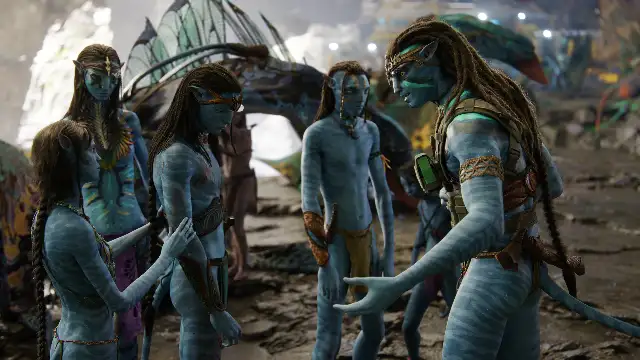I’ve
And I’ve learned that you really shouldn’t bet against James Cameron when he’s got a chance to get wet.

It helps that we’ve gotten this world established already. Pandora is a lush, gorgeous, beautiful environment that was brought to us with the most basic of stories to ease audiences in. Cameron takes the kid gloves off this time and expands his playground by taking us to the coast, allowing new regional forms of his Na’vi to rise and a whole new group of flora/fauna to delight. I’ve long maintained that the first film is a gorgeous visual experiment and works best when we’re allowed to dance through the sky with dragons instead of sitting in a room talking. Gone are the boring bits, the instances of Sam Worthington monologuing exposition to a go-pro camera and the clunky dialogue used to explain a rehashed story in a new setting, replaced by a world compromised now of mostly native inhabitants that are finally allowed to dominate the story. This is no longer about a human trying to fit into a new culture but rather what happens when two cultures combine and learn from one another.
And just what has old Jake Sully (still played by Sam Worthington and his barely-contained Australian accent) been up to since the first Avatar? We’re shown a montage during the first block of the runtime that informs us of his children: Neteyam (Jamie Flatters), the oldest son and the most like his militant father, Lo’ak (Britain Dalton), a headstrong middle child bursting at the seams for some freedom, Tuk (Bailey Bass), a tiny Na’vi whose main character trait is “adorable,” and Kiri (Sigourney Weaver), the immaculate spawn of Weaver’s avatar body (don’t ask because it’s not explained) that has been adopted by Jake and his wife, Neytiri (Zoe Saldaña). They’re joined by a human boy by the name of Spider (Jack Champion), a kid left behind when the humans were kicked off the world fifteen years prior for “reasons” and who has joined the Na’vi as an adopted son.

Cards on the table I don’t really know that I care much for these kids. They’re perfectly acceptable in their tropes, growing more interesting when they begin interacting with the Metkayina seaside tribes and learning to live in the water, but they never seem to grow beyond very basic characters. The one exception is Kiri, who is sort of a miracle of a character that grounds all the rest as they revolve around her “chosen one” narrative. There’s a delicate grace to how Cameron chooses to handle this most classic of character arcs, teasing out things that he will now validate in later installments, and it allows Sigourney Weaver to convincingly play a troubled young girl at the age of seventy-three. Beyond connecting with their deity, Eywa, the kid is just a charming-yet-sad teenager that’s picked on for things like having an extra finger, not having real parents, and it’s astounding that Weaver is able to capture all of this and make it feel connective. Worthington may have shown the most improvement since the last film but it’s Sigourney Weaver that steals the show.
Performance has been a difficult thing to discuss when talking about this franchise. Worthington was just a hair away from “bad” in 2009 and has made some big leaps forward, carried by the motion capture that allows him to finally just exist as a Na’vi. He’s joined onscreen by a plethora of new performers, the most exciting of which is Kate Winslet as Ronal. James Cameron yet again nearly drowned the Titanic actress as she set a new record for holding breath underwater and it all seems for naught. I needed a lot more of some of the adult characters, but hers is just charming enough to carry her above the others in a mo-cap performance that feels fully realized.

That tech that allows these performances is a huge part of why this movie surpasses its predecessor. Cameron’s wait for the technology to catch up with his vision seemed like Ahab’s hunt for his white whale, but when the director wants to take his story to the sea it’s best not to second-guess him. Every inch of this looks like nothing I’ve ever seen before, utilizing a slightly higher framerate than usual and 3D imagery that changes the game yet again. Whether it’s a conversation by firelight or a knife fight on a sinking ship Cameron has made a meal of the promised advancement in motion capture technology, bringing a new aspect of this world alive in a way that will never be as good as it is on the big screen. I don’t care that I’ll never love this as much as I do in this moment because we have once again been gifted with the absolute most, a celebration of just how inventive and groundbreaking film can be, and there’s a majesty to stories that feel this unique and timeless.
I could not have predicted the joy I’d feel returning to Pandora. Whatever your stance on the first film this one surpasses it, leaving me more excited than ever for the journey Cameron wants to take us on in his upcoming sequels. Nothing will compare to the experience of seeing this in 3D on the big screen and I urge you to see it that way. Just an overwhelming and lovely experience in every way.
Avatar: The Way of Water is currently playing in theatres.
Source link
